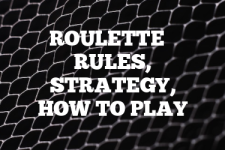Omaha Poker: A Guide to the Game Rules, Instructions & Basic Winning Strategy
Introduction
Omaha Poker (sometimes called Omaha Hold’em) is a card game that’s similar to Texas Hold’em, which I’ve covered previously, but with a few key differences that make it unique. Omaha Poker is one of the more challenging and exciting ones out there. It’s a game that combines skill, strategy, and a bit of luck.

The game originated in the United States, and its exact origins are a bit unclear, but it definitely gained popularity in the 1980s and has been a staple in casinos and home since then.
In Omaha Poker, each player is dealt four private cards (known as ‘hole cards’) that belong to them alone. Five community cards are dealt face-up on the ‘board’. In Omaha games, each player must use exactly two of their hole cards together with exactly three of the community cards to make the best five-card poker hand. No more, no less. This is different from Texas Hold’em, where you can use any combination of your hole cards and the community cards.
Quick Tip for Omaha Poker
Always remember you MUST use two of your hole cards and three community cards to make your hand – it’s a common mistake to forget this!
Rules for playing Omaha Poker
The game starts with the dealer dealing four cards to each player. These cards are your hole cards and are not shown to the other players. After the cards are dealt, a round of betting occurs, starting with the player to the left of the dealer.
After the first betting round, three community cards are dealt face-up on the board. This is called the ‘flop’. Another round of betting follows, where players can check, bet, raise, or fold. Then, a fourth community card is dealt, known as the ‘turn’, followed by more betting. Finally, the fifth community card, the ‘river’, is dealt, and the last round of betting takes place. You’ll be familiar with these terms if you’ve played traditional poker, or else read my guide on it.
Players must make the best five-card hand using exactly two of their hole cards and three community cards. The player with the best hand wins the pot. If two or more players have the same hand, the pot is split evenly between them. There are also variations of Omaha Poker, such as Omaha Hi/Lo, where the pot is split between the highest and lowest hands.
Equipment and Setup for Omaha Poker
To play Omaha Poker, you need a standard deck of 52 playing cards and poker chips for betting. The game can be played with 2 to 10 players, but it’s best with 5 to 9 players. Each player starts with an equal number of chips, and the game is played on a table with a designated dealer.
How to Play Omaha Poker
Playing Omaha Poker involves several key game mechanics:
- Setup: Choose a dealer, shuffle the deck, and deal four hole cards to each player.
- Gameplay: Engage in a series of betting rounds and card dealings (flop, turn, river).
- End of the Game: Reveal hands after the final betting round and determine the winner.
Here are the gameplay phases:
- Pre-flop: Betting round before the flop is dealt.
- Flop: Deal three community cards and have another betting round.
- Turn: Deal one more community card followed by another betting round.
- River: Deal the final community card and enter the last betting round.
- Showdown: Players reveal their hands to determine the winner.
Overall, there are four rounds of betting in a game of Omaha Poker.
How to Win at Omaha Poker
Winning at Omaha Poker requires a good understanding of hand rankings and odds. Since you must use two hole cards, starting hands with high-potential card combinations are important. Knowing the probabilities of certain hands and the house edge can also help you make better decisions.
For example, a starting hand with a pair of aces is strong, but a hand with a pair of aces and two high suited cards is even stronger because it has the potential to make a flush or a full house. Understanding these odds and how they change as the community cards are dealt is key to winning at Omaha Poker.
Best Strategies for playing Omaha Poker cards
When it comes to strategy, Omaha Poker is all about playing the odds and reading your opponents. Here are some strategies:
- Starting Hands: Select hands that have a good chance of developing into strong combinations after the flop (look at the basic strategy decision-making table provided below).
- Position: Play more hands when you’re in a late position, as you’ll have more information about your opponents’ actions.
- Aggression: Bet and raise when you have a strong hand to build the pot and protect your hand.
- Bluffing: Occasionally bluff to keep your opponents guessing, but do it sparingly.
Here’s a basic strategy table for Omaha Poker, indicating actions based on your hole cards:
| Hole Cards | Action |
|---|---|
| A-A-x-x | Raise or re-raise |
| K-K-x-x | Raise or re-raise |
| Q-Q-x-x | Raise or re-raise depending on position |
| J-J-x-x | Raise or re-raise depending on position |
| 10-10-x-x | Raise or re-raise depending on position |
| 9-9-x-x | Raise in late position, consider raising in mid position |
| 8-8-x-x | Raise in late position, consider raising in mid position |
| 7-7-x-x | Raise in late position |
| 6-6-x-x | Raise in late position |
| 5-5-x-x | Raise in late position, consider raising in mid position |
| 4-4-x-x | Raise in late position, consider raising in mid position |
| 3-3-x-x | Raise in late position |
| 2-2-x-x | Raise in late position |
| A-K-Q-J (suited) | Raise or re-raise |
| A-A-K-K (double suited) | Raise or re-raise |
| A-A-x-x (double suited) | Raise or re-raise |
| A-K-J-10 (suited) | Raise or re-raise depending on position |
| A-K-Q-10 (suited) | Raise or re-raise depending on position |
| A-A-x-x (rainbow) | Raise or re-raise |
| A-K-K-x (double suited) | Raise or re-raise |
| A-Q-Q-x (double suited) | Raise or re-raise depending on position |
| A-J-J-x (double suited) | Raise or re-raise depending on position |
| A-10-10-x (double suited) | Raise or re-raise depending on position |
| K-K-Q-Q (double suited) | Raise or re-raise |
| K-K-J-J (double suited) | Raise or re-raise depending on position |
| K-K-x-x (double suited) | Raise or re-raise depending on position |
| K-Q-J-10 (suited) | Raise or re-raise depending on position |
| K-K-x-x (suited) | Raise or re-raise depending on position |
| K-Q-Q-J (double suited) | Raise or re-raise depending on position |
| K-J-J-x (double suited) | Raise or re-raise depending on position |
| K-10-10-x (double suited) | Raise or re-raise depending on position |
| Q-Q-J-J (double suited) | Raise or re-raise depending on position |
| Q-Q-x-x (double suited) | Raise or re-raise depending on position |
| Q-J-10-10 (suited) | Raise or re-raise depending on position |
| Q-Q-x-x (suited) | Raise or re-raise depending on position |
| Q-J-J-10 (double suited) | Raise or re-raise depending on position |
| Q-10-10-x (double suited) | Raise or re-raise depending on position |
| J-J-10-10 (suited) | Raise or re-raise depending on position |
| J-J-x-x (double suited) | Raise or re-raise depending on position |
| J-10-10-x (double suited) | Raise or re-raise depending on position |
| 10-10-9-9 (suited) | Raise or re-raise depending on position |
| 10-10-x-x (double suited) | Raise or re-raise depending on position |
| 10-9-9-8 (double suited) | Raise or re-raise depending on position |
| 9-9-8-8 (suited) | Raise or re-raise depending on position |
| 9-9-x-x (double suited) | Raise or re-raise depending on position |
| 8-8-7-7 (suited) | Raise or re-raise depending on position |
| 8-8-x-x (double suited) | Raise or re-raise depending on position |
| 7-7-6-6 (suited) | Raise or re-raise depending on position |
| 7-7-x-x (double suited) | Raise or re-raise depending on position |
| 6-6-5-5 (suited) | Raise or re-raise depending on position |
| 6-6-x-x (double suited) | Raise or re-raise depending on position |
| 5-5-4-4 (suited) | Raise or re-raise depending on position |
| 5-5-x-x (double suited) | Raise or re-raise depending on position |
| 4-4-3-3 (suited) | Raise or re-raise depending on position |
| 4-4-x-x (double suited) | Raise or re-raise depending on position |
| 3-3-2-2 (suited) | Raise or re-raise depending on position |
| 3-3-x-x (double suited) | Raise or re-raise depending on position |
| 2-2-x-x (double suited) | Raise or re-raise depending on position |
| Any other combination | Fold |
This table provides general guidelines for actions based on hole cards in Omaha Poker. Remember that the specific action may vary based on factors such as table position, stack sizes, opponent tendencies, and the dynamics of the current hand. It’s essential to adapt your strategy accordingly and consider all relevant factors when making decisions in the game.
Variations
There are several variations of Omaha Poker, including:
- Omaha Hi/Lo: The pot is split between the highest and lowest hands.
- Pot-Limit Omaha: Bets and raises are limited to the current size of the pot.
- No-Limit Omaha: Players can bet any amount of their chips at any time.
Scenarios
Good and bad scenarios in Omaha Poker can greatly affect your strategy. For example, if you have a strong hand on the flop, you might want to bet big to protect it. On the other hand, if you have a weak hand, you might want to fold or wait to see if the turn or river improves your hand.
Always assess the strength of your hand in relation to the community cards and your opponents’ potential hands. This will help you make the best decisions in any scenario.
Frequently Asked Questions about playing Omaha Poker game
Here are some common questions and answers:
Q: Can I use more than two of my hole cards to make a hand?
A: No, you must use exactly two hole cards and three community cards.
Q: What’s the best starting hand in Omaha Poker?
A: A pair of aces with two high suited cards is considered very strong.
Q: How important is position in Omaha Poker?
A: Position is very important, as it gives you more information about your opponents’ actions.
External Links
For more information on Omaha Poker, check out these resources:
Play Omaha Hold’em Online Simulator (free, no registration)

A digital native around since the early days of online gaming communities around 2001. An early contributor to the cult gaming site ClanTemplates, Adam has spent years giving free gaming resources to the community. With BoardCards, Adam is most experienced and commonly writing the articles on Strategy multi-player games like Settlers of Catan and Avalon. His first introduction to board games was via Mancala, an Egyptian-origin stone game and one of the oldest known games still played worldwide. Contact me via email



